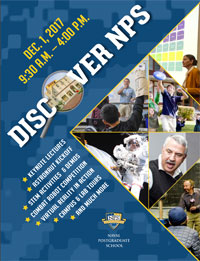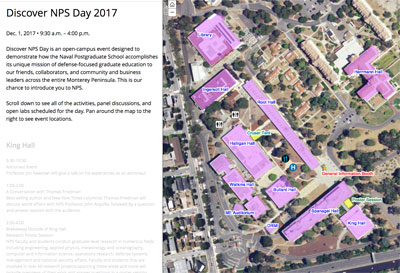Discover NPS 2017 - Discovery Day at NPS
Discover NPS Day
DEC 1, 2017 | 9:30 A.M. - 4:00 P.M. | OPEN TO THE PUBLIC WITH PHOTO ID
ASTRONAUT GUEST LECTURE • KEYNOTE LECTURES • STEM ACTIVITIES • COMBAT ROBOT COMPETITION • VIRTUAL, AUGMENTED REALITY • CAMPUS + LAB TOURS
Discover NPS Day is an open-campus event designed to demonstrate how the Naval Postgraduate School accomplishes its unique mission of defense-focused graduate education to our friends, collaborators, and community and business leaders across the entire Monterey Peninsula. This is our chance to introduce you to NPS.
Events and activities include several displays of science and technology in action through a variety of STEM activities, in addition to a live address from a former NASA astronaut. We also hope to engage other sectors of our regional population, with relevant, topical keynote and breakout lectures by world-renowned experts from our faculty ranks and beyond.
Capture something cool at Discover NPS Day? Share it, tag us, or just send it to our Social Media team at pao@nps.edu.
For regional schools planning to attend Discover NPS Day, please contact NSA Monterey School Liaison Officer Dr. Cheryl McCloud, cgmcclou@nps.edu, to coordinate.
Want to get a head start on planning your day of discovery at NPS?
Download the Discover NPS Day Program or Access our Online Interactive Discover NPS Day Map
DISCOVER NPS DAY SCHEDULE
Youth-Focused Activities
9:30 a.m. - 10:30 a.m. Welcome from the International Space Station / Astronaut Guest Lecture | King Auditorium
10:30 a.m. - 2:00 p.m. STEM Activities and Demonstrations | Several locations across the Academic Quad
* Students bringing their own lunches can eat at designated locations on campus. Food is also available for purchase in the El Prado Room in Herrmann Hall, and the Del Monte Café near Dudley Knox Library.
Adult-Focused Activities
1:00 p.m. - 2:00 p.m. A Conversation on World Affairs ... with Tom Friedman | King Auditorium
2:30 p.m. - 3:30 p.m. Breakout Panel Sessions | DRMI Auditorium, ME Auditorium, Ingersoll, Rm. 122
2:00 p.m. - 4:00 p.m. Research Poster Session | Lab Tours, Various Locations
GUEST LECTURES AND PANEL DISCUSSIONS
KEYNOTE
A Conversation with Thomas Friedman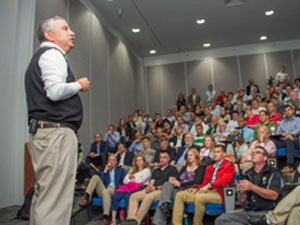
1:00 p.m. – 2:00 p.m. | King Auditorium
Best-selling author and New York Times columnist Thomas Friedman will discuss world affairs with NPS Professor John Arquilla, followed by a question-and-answer session with the audience.
PANEL SESSIONS
We Do Humanitarian Assistance and Disaster Relief Anyway, Why Not Do It Smartly?
Dr. Aruna Apte, Associate Professor, Operations and Logistics Management, NPS Graduate School of Business and Public Policy
2:30 p.m. – 3:30 p.m. | Ingersoll Hall, Room 122
Due to their specialized resources, services, and capabilities America’s Navy and Marine Corps are uniquely qualified and able to support humanitarian assistance and disaster relief (HADR) to serve the needs of others and provide care in times of human suffering. An important question, whether the organizations will be able to continue and sustain HADR in an environment of fiscal austerity, can only be answered if efficiency and efficacy of these operations are studied.
Cyber at NPS - The Effective Integration of Education and Research
Senior Lecturer Chris Eagle, Department of Computer Science
2:30 p.m. – 3:30 p.m. | Mechanical and Aerospace Engineering Auditorium
This panel’s discussion shows the inherent relationship between research and education. This relationship advances knowledge domains and enhances student education that is in turn, taken into the fleet. Please join us for this discussion and Q&A opportunity.
Our Climate Is Changing - Relevant Research at NPS
A series of topical discussions led by faculty in NPS’ Meteorology, Oceanography and National Security Affairs departments.
2:30 p.m. – 3:30 p.m. | DRMI Auditorium
> Topic 1 - Observations of Arctic Ice Changes in the Last Decade 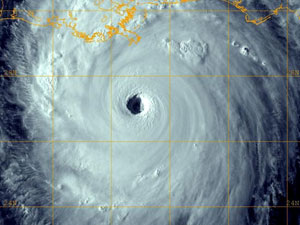
Research Professor Tim Stanton, Department of Oceanography
Dramatic decreases in late summer ice area and volume have been observed particularly in the Canada Basin, north of Alaska. Understanding the causes of this dramatic ice retreat has been the focus of collaborative field studies over three decades with NPS scientists. Examples of observations of feedbacks that are accelerating the ice retreat will be discussed.
> Topic 2 - Climate Change and Weather Extremes
Lecturer Tom Murphree, Department of Meteorology
Human emissions of carbon dioxide and other greenhouse gasses have made major contributions to climate change, especially in the last 50 years. These include increases in the frequency and intensity of extreme events, such as heat waves, storms, and flooding. We’ll discuss examples of how climate change affects extreme events, and how people are responding to the increased risk of extreme events.
> Topic 3 - Modeling and Satellite Observations of Polar Sea Ice Changes
Associate Research Professor Andrew Roberts, Department of Oceanography
Sea ice covers 7-10 percent of the world's oceans and is undergoing a rapid transformation in the Arctic. Perennial sea ice in the high-north is giving way to seasonally ice-free waters, increasing navigability of the Arctic Ocean and its marginal seas, and changing the geopolitics of the region. Collaborative efforts by scientists to model and predict the changes in Arctic sea ice using supercomputers, including within the Department of Defense, have so far been too conservative; the decline of Arctic sea ice in our models occurs too slowly as compared to sophisticated satellite observations. This talk will briefly describe how the models work, their fallibilities, future improvements and prediction efforts, and satellite observations being used to monitor Arctic change.
> Topic 4 - Climate Change and U.S. National Security: Key Issues
Assistant Professor Emily Meierding, Department of National Security Affairs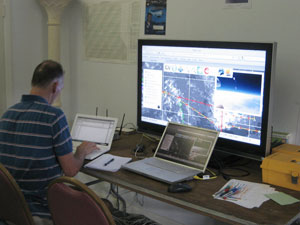
This talk highlights the central ways that climate change could negatively impact U.S. national security – threatening military infrastructure, increasing the frequency of humanitarian assistance/disaster relief missions, destabilizing partner countries, and intensifying Arctic territorial disputes – and identifies potential policy responses.
> Topic 5 - Global Sea Level Change Processes
Research Professor Tim Stanton, Department of Oceanography
While sea ice retreat in polar regions have many societal implications, because the ice is floating on the ocean, there is no contribution to sea level change. In contrast, changes in the volume of massive ice sheets in Greenland and Antarctica through both surface melting and ice flow off the continent into the ocean directly affect sea levels across the planet. A high-risk field program studying the very active Pine Island Glacier system in Western Antarctica explores the role of ocean – ice interactions under the broad ice-shelves that project out into the ocean.
STEM ACTIVITIES AND DEMONSTRATIONS
SPACE SYSTEMS ACADEMIC GROUP
Superconductivity
David Rigmaiden
10:30 a.m. - 12:30 p.m. | Bullard Hall, Rm. 106B
Superconductivity is a phenomenon of zero electrical resistance and expulsion of magnetic flux fields. Superconductors can be used for magnetic levitation; super magnets used in MRI medical imagers, smart grid electrical power generation, and transmission systems, to name a few.
Bottle Rocket Launchers
David Rigmaiden
10:30 a.m. - 12:30 p.m. | Academic Quad in front of Spanagel Hall
Sir Isaac Newton’s third law states that for every action in nature, there is an equal and opposite reaction. In the soda bottle, thrust is produced through action and reaction ... The air pressure inside the bottle ejects (action) the water and remaining gas downward, with the thrust produced (reaction) launches the bottle upwards.
Vibration and Dynamics
Dan Sakoda
10:30 a.m. - 12:30 p.m. | Bullard Hall, Rm. 202
Structures behave differently in a dynamic environment. This demonstration shows the behavior of an aluminum beam (yard stick) when driven at one end by a cyclical forcing input.
Gravity Assist
Dan Sakoda
10:30 a.m. - 12:30 p.m. | Bullard Hall, upstairs Bullard across from 202 (in the Space-for-Space hallway)
This demonstration shows how gravity can be used to alter the trajectory of a spacecraft, such as in the ‘free return’ orbit used by the Apollo missions.
NPS DEPARTMENT OF PHYSICS
Acoustics Show - The Science of Sound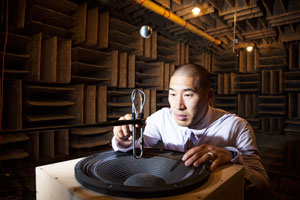
Dr. Andres Larraza and Dr. Bruce Denardo
Spanagel Hall, SP-117 | See schedule for showtimes
A fun and exciting show packed with mind blowing sound demonstrations.
E&M - The Amazing Electricity and Magnetism Show
Joe Blau and Warren Tomlinson
Spanagel Hall, SP-136 | See schedule for showtimes
Unlock the mysteries of electricity and magnetism through this exciting and (sometimes jolting) physics show.
Lasers and Optics Show - Light, Lasers, and Night Vision
Dr. Frank Narducci and Dr. Gamani Karunasiri
Spanagel Hall, SP-135 | See schedule for showtimes
A jaw dropping, interactive show that reveals the powerful secrets of light manipulation.
Mechanics Show - The Science of Motion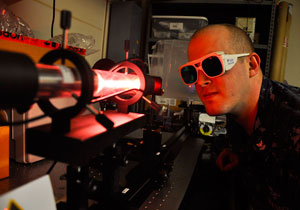
Dr. Ray Gamache
Spanagel Hall, SP-127 | See schedule for showtimes
This fun and exciting mechanics show, utilizing simple, everyday experiences, is jam packed with exciting demonstrations, and is guaranteed to blow your mind.
NPS Physics Demos Schedule
| 9:30 a.m. - 10:15 a.m. | Acoustics Show | E&M Show |
| 10:15 a.m. - 11:00 a.m. | Lasers and Optics Show | Mechanics Show |
| 11:00 a.m. - 11:45 a.m. | Acoustics Show | E&M Show |
| 11:45 a.m. - 12:30 p.m. | Lasers and Optics Show | Mechanics Show |
| 12:30 p.m. - 1:15 p.m. | Acoustics Show | E&M Show |
| 1:15 p.m. - 2:00 p.m. | Lasers and Optics Show | Mechanics Show |
3D Mapping with Light
Richard C Olsen and Zishan Hameed
10:00 a.m. - 2:00 p.m. | Spanagel Hall, SP-103
Watch us map a human being with laser beams. You won’t want to miss this.
Nitrogen Cannon - A Crowd Favorite! 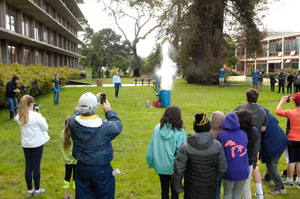
Dr. Kevin Smith and Abe Clark
The lawn in front of Spanagel Hall | Launching every 30 minutes starting at 10:00 a.m.
A dramatic demonstration of the power released when a liquid converts to a gas under pressure, launching tennis balls over buildings.
The Guided Acoustic Anechoic Chamber Tour
10:00 a.m. - 2:00 p.m. | Spanagel Hall, SP-019
Be Careful! This room plays tricks on your mind. Take a tour of the anechoic chamber and experience what a “dead room" sounds like. Guaranteed to be amazed and weirded out.
NPS Model Shop
Matt Small
10:00 a.m. - 2:00 p.m. | Spanagel Hall, SP-037
Turning dreams into reality. Discover the World of 3D printing and computer controlled machining. Take a tour the Physics Model Shop and see where brilliant ideas come to life.
AXV Lab - Robots! Robots! Robots!
Steven Jacobs
10:00 a.m. - 2:00 p.m. | Spanagel Hall, SP-111
The future of autonomous robotics can be found here. Take a tour of the AVX Laboratory to see what the future holds.
DISCOVER NPS DAY HIGHLIGHTS
Research Poster Session
2:00 p.m. - 4:00 p.m. | King Auditorium Breezeway
NPS faculty and students conduct graduate-level research in numerous fields including engineering, applied physics, meteorology and oceanography, computer and information science, operations research, defense systems management and national security affairs. Faculty and students that are involved in over 60 research projects spanning these areas and more will provide overviews of their work and answer questions in a poster session outside of King Auditorium following the lecture by Tom Freidman.
An Introduction to the MOVES Institute - Virtual Reality, Augmented Reality, 3D Printing (Additive Manufacturing) and More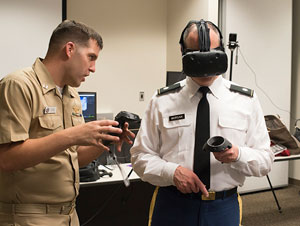
Dr. Amela Sadagic and Visual Simulation and Game-Based Technology team: Erik Johnson, Ryan Lee, Michael Guerrero and Eric Heine
10:30 a.m. - 12:00 p.m., 2:00 p.m. - 4:00 p.m. | Watkins Hall, Rm. 275/285
Posters, virtual reality activities and games, augmented reality, stereoscopic displays, various haptic and 3D input devices, 3D scanners and 3D printer will be available for visitors to see and play with. Select elements of MOVES Mini Museum collection will also be on display.
MOVES is both a degree and Institute at the Naval Postgraduate School. The Modeling, Virtual Environments, and Simulation (MOVES) Institute supports the MOVES degree through defense focused research and educational support in the areas of computer modeling, virtual environment, and simulation technologies. The primary focus of the MOVES degree program is to educate military officers in the technologies involved in computer modeling and simulation so that graduates can effectively employ those technologies to support mission areas such as training, analysis, acquisition, and operations across the Navy and Department of Defense.
Welcome to the RoboDojo
Sensei Kristen Tsolis
10:30 a.m. - 4:00 p.m. | Root Hall, Rm. 125 A/B
The RoboDojo is an innovation space where NPS students, staff, faculty and friends can come 'tinker' and learn about robot components and systems. Whether you’re 5 or 75, the RoboDojo is designed to promote informal hands-on learning, with open hours and volunteer mentors to help the NPS community learn about:
• Rapid Prototyping (with 3D printers and laser cutters);
• Embedded Computing (with Arduino and Raspberry Pi);
• Basic Electronics (with varied electronics and breadboard components);
• Robotic Software Programming (Robot Operating System in Python);
• And much more!
The RoboDojo represents a grassroots initiative to promote collaborative and community learning, so feel free to stop by and learn about robots!
Ant Weight Combat Robots
10:45 a.m. – 1:00 p.m. | Ingersoll Hall, Rm. 122
Come join us for some combat robot action! Ant Weight robots weigh up to 1 lb max, are relatively easy to build, and teach about robotics on a simpler scale. Kids up to 12 will be competing from 10:45-11:45, and 13 and up will be competing from 11:45-1:00 p.m.
CRUSER - Consortium for Robotics and Unmanned Systems Education and Research
10:30 a.m. - 4:00 p.m. | On the Quad near Ingersoll Hall
The Consortium for Robotics and Unmanned Systems Education and Research (CRUSER) provides a collaborative community for the advancement of educational and research endeavors in robotics and autonomy across the naval enterprise, the Department of Defense, academia and industry. CRUSER supports efforts – both internal and external to NPS – through collaborative forums, interactive activities and events, and by awarding seed funds to promising research efforts in this rapidly expanding and important topic area. CRUSER membership is free, and open to all those who have an interest in robotics and autonomy. Stop by the CRUSER tent at Discover NPS Day to learn more or visit cruser.nps.edu.
TRAC Monterey
Lt. Col. Michael Teter
2:00 p.m. - 4:00 p.m. | Watkins Hall - North (1st Floor)
The U.S. Army Training and Doctrine Command Analysis Center (TRAC), Monterey performs applied research into numerous domains that inform key decisions made by Army and Joint Leaders. Join us for demonstrations and presentations on our current interdisciplinary efforts which include foundations in mathematics, computer science, and systems engineering. Key topics being presented: (i) Army Cyber Anomaly Detection, (ii) Data Mining and Simulation, (iii) Systems Engineering, (iv) Aircraft Routing and Threat Avoidance.
ADDITONAL OPEN LABORATORIES
Systems Engineering Lab
Albert Jordan
2:00 p.m. - 4:00 p.m. | Bullard Hall, Rm. 224B and 224C
Showcasing 3D Printers, Virtual Reality Headsets, Ground Robots and Drones
Hydrodynamics Lab
Joseph Klamo
2:00 p.m. - 4:00 p.m. | Halligan Hall First Floor
The hydrodynamics lab contains an operational towing tank with a newly-added wave making capability. This lab will showcase an on-going experimental set-up to measure the loads on a submerged UUV model caused by the generated waves.
EEMS (Engineering Enclave for Maritime Security)
Ric Romero
2:00 p.m. - 4:00 p.m. | Spanagel Hall, Rm. 303
Showcasing covert communications using radar, and a replica of a ship’s bridge enabled for cyber experimentation.
Computer Science Lab
Dr. Peter Ateshian
2:00 p.m. - 4:00 p.m. | Glasgow East Rm EB10 (Down the exterior staircase near the Cebrowski Institute)
Known as the “Bat Cave.” Demonstrations of the use of free space optics for high speed data communications. Raspberry Pi-3 QR code Python demonstration, Laser diode and PV Morse code OOK modulation with Rx text and audio output, Two LED QR code panels with flashing 256 color wheel standard demonstration, Hands-on SensorTile demo with SmartEnergy)
Spacecraft Robotics Laboratory
Dr. Josep Virgili-Llop, Dr. Marcello Romano
10:00 a.m. – 12:00 p.m. / 2:00 p.m. – 4:00 p.m. | Halligan Hall, Rm. 024
Showcasing the POSEYDIN test-bed for space flight emulation.


